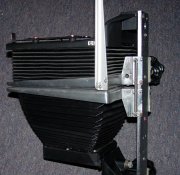The blue / green system of split printing is the "poor man's answer" to a dicro head or multicontrast cold light head. I know because I used the blue/ green system with inexpensive plastic gels myself.
I'll try and make this as short as possible. Variable contrast filters are "Subtractive" in nature, that is to say they subtract or take away certain parts of the color spectrum, all the CC 40Y filter does is bring a strong blue cold light head back to a neutral color. This to becomes another subtractive filter, in conjunction with magenta multi contrast filters you have now added two filters, which add considerable length to your printing times.
When you introduce a straight blue filter it becomes additive light, meaning you are just magnifying the intensity of the blue cold light. Blue light will maximize the contrast that the paper is capable of, yes there is density to the filter but it does not significantly increase exposure times. Likewise, with the green filter you are adding the color of light, which effects the lower contrast portion of the emulsion.
Typically, you use these filters in conjunction with one another to effect very specific contrast too more localized areas of the print. Usually, one would "set the exposure" with the blue filter and then add whatever amount of green light is necessary to provide detail and information in the highlights. It is somewhat trial and error but should quickly allow you to dial in many difficult negatives to your liking.
Lastly, I use plastic "theatre gels" made by Rosco above the negative. They are very inexpensive and easy to use. I use a deep blue #69 and medium green very similar to a #58 green filter. Total cost of a 2'x2' sheet was about $10.00 per color.















